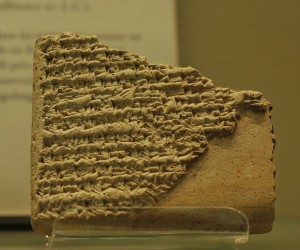SARGON OF AKKAD
Sargon fu il fondatore della dinastia accadica e della capitale del regno, Akkad. Le sue origini sono piuttosto oscure, dalla tradizione che lo riguarda sappiamo che proveniva dal nord e che fu coppiere del sovrano di Kish, Ur-Zababa. Con Sargon si ha l’ascesa dell’elemento semitico, culmine di processi culturali già in atto. La vicenda del primo re di Akkad si può riassumere in 3 fasi principali:
1. L’inizio del suo regno fu segnato da importanti campagne militari, che interessarono soprattutto la parte meridionale di Sumer, sconfiggendo Lugalzagesi di Uruk e gli ensi delle città di Ur, E-ninmar ed Umma. Lo stesso Sargon nelle sue iscrizioni proclama la sua superiorità teorica dal mare Inferiore al mare Superiore, anche se in realtà rimangono indipendenti l’Elam e Mari. Ruolo particolare fu accordato a Kish e Nippur.
2. A questa prima fase ne seguì una di assestamento e organizzazione di carattere prettamente commerciale, infatti Akkad intratteneva una fitta rete di scambi con le regioni di Dilmun (Bahrein), Magan (Oman), Melukhkha (Valle dell’Indo). L’avanzata di Sargon si arrestò a Tuttul, qui però afferma che il dio Dagan gli concesse l’accesso alle risorse di Mari, Yarmuta, Ebla e del Paese alto fino alla foresta dei cedri (Amano) e le montagne d’Argento (Tauro). Il potere effettivo dell’impero accadico si estendeva però da Tuttul alle sponde mesopotamiche del Golfo Persico.
3. Nella fase finale del suo regno stabilì la situazione ideale per quelle che saranno le azioni dei suoi successori, importante fu la vittoria sull’Elam e Barakhshi, i quali però rimasero formalmente indipendenti.
Con Sargon la figura del sovrano evolve con un repentino passaggio dalla precedente visione della regalità basata su caratteri cultuali e amministrativi, a una vera e propria regalità eroica. Enlil e gli altri dei concedono ai re di Akkad il dominio su tutto il mondo. Si assiste a un primo tentativo di riunire sotto un solo governo un enorme territorio, composito e fortemente particolareggiato. La nuova immagine del sovrano ha caratteri derivati dal nord semitico e mal si accorda con la visione sumerica. I re accadici tentarono di far breccia nel sistema politico-religioso di Sumer, stabilendo un rapporto privilegiato con il capo del pantheon e ponendosi automaticamente in posizione di preminenza rispetto alle divinità locali. La politica religiosa del primo sovrano di Akkad fu accorta, nominò la figlia, Enkheduanna, sacerdotessa di Nanna-Sin a Ur e probabilmente, in parallelo una sacerdotessa sumerica fu installata nel tempio di Ishtar a Akkad. Lo scopo primario di tale azione fu quello di compattare la frattura etnico-religiosa tra il Nord ed il Sud.
Anche il panorama artistico viene investito dalla nuova temperie culturale, l’arte viene rivista in chiave propagandistica e celebrativa.
———————————————————————————————————
Sargon founded the Akkadian dynasty and the capital of the new kingdom, Akkad. His origin are somewhat obscure, according to tradition, we know that he came from the North and he was the cupbearer of the king of Kish, Ur-Zababa. The semitic element prevails with him, the culmination of a process that originated long before.
The story of Sargon can be divided in three phases:
1- The beginning of his kingdom is characterized by an intense military policy, mostly in the southern Sumer, in fact he defeated Lugalzagesi, king of Uruk, and the ensi of Ur, E-Ninmah and Umma. In his inscriptions Sargon proclaims himself ruler of the Upper and Lower sea (although Elam and Mari remain independent). He gave a special position to Kish and Nippur.
2- The second phase was characterized by important commercial activities, in fact Akkad mainteined an extensive network of trades with Dilmun (Bahrein), Magan (Oman) and Melukhkha (Indus Valley). The advance of Sargon stopped in front of Tuttul; here the God Dagan gave him the admittance to the resources of Mari, Yarmuta, Ebla and the Upper lands until Amano and Tauro. Although in reality, the Akkadian kingdom was extended from Tuttul to Mesopotamian shores of the Persian Gulf.
3-In the last part of his reign, he established the ideal situation for the future policies of his successors. The victories against Elam and Barakhshi was really important, but nevertheless they kept both their independence, at least formally.
With Sargon the idea of the ruler changes from the ancient vision of regality which was founded on cultural and administrative characters, to a new heroic kingship. Enlil and the other Gods gave to Akkadian kings the power throughout the world. The Akkadian dynasty has been the first one in history to unify an enormous, richly composite territory, under its domination. The new image of the ruler has fresh characters which came from the Semitic North and it’s really different from the Sumerian one. Akkadian kings broke into the political and religious system of Sumer and placed theirselves in a leading position compared to the local deities. Sargon designated his doughter, Enkheduanna, as priestess of Nanna-Sin in Ur, at the same times a Sumerian priestess was placed in the temple of Ishtar in Akkad. The purpose of this policy was unifying the broke between North and South. We can see also many changes in the artistic scene, with the preminence of the celebratory and propagandistic character.
